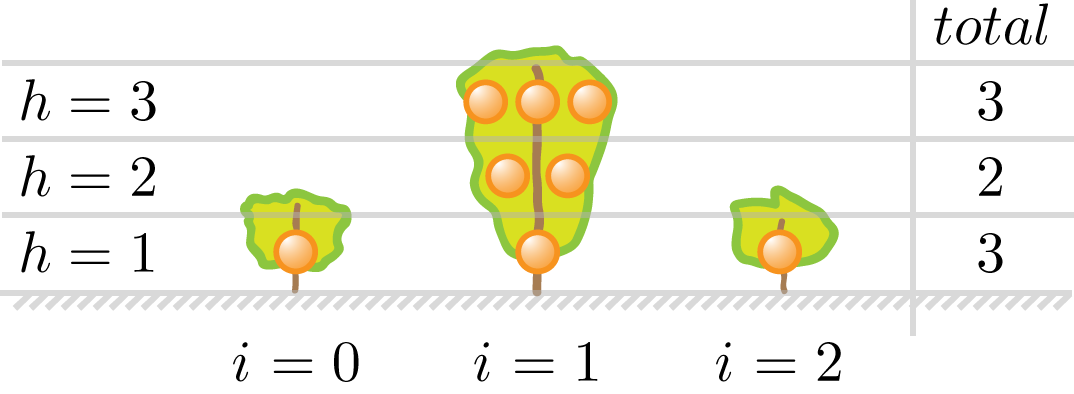Boranges
Output: Standard Output (stdout)
Memory limit: 64 megabytes
Time limit: 1.0 seconds
You own a Borange orchard. You can deploy your super duper auto picker 5000 to collect Boranges from all your trees at some fixed height h. However, each time you deploy the auto picker it costs c cents in fuel. Therefore, you only want to send out the auto picker at that height if you can collect enough fruit to make a profit. Each Borange your auto picker collects earns you 5 cents. You decide to make a program to calculate the number of heights h at which you should deploy your auto picker.
Luckily, you know the height of every tree in your orchard. You have N trees total. The ith tree, 0\le i \lt N, has a height of h_i. When the auto picker is set to some height h, a tree will yield h pieces of fruit. However, if the auto picker height h is strictly greater than the tree height h_i, no fruit is collected from that tree. The example below shows the total fruit yield at each auto picker height h for three trees of heights h_0=1, h_1=3, and h_2=1 (same as the sample input and output).

With a cost of c=10 cents, the total yield must be greater than 10 cents to turn a profit. Therefore, the picker should be deployed twice - for h=1 and h=3. For three Boranges, the income is 5 \times 3=15 cents giving a total profit of 5 cents. However, two Boranges at h=2 only make 10 cents and, therefore, no profit.
Input
- The first line contains two space separated integers N (the number of trees) and c (the cost to refuel in cents). The cost will always be a multiple of 5. It also holds that 1 \le c \le 100{,}000{,}000{,}000.
- The remaining N lines each contain a height h_i corresponding to the ith Borange tree in your orchard.
Output
- Print the number of times you should deploy the auto picker. In other words, the number of heights h for which collecting Boranges will make a profit.
Subtasks
- Subtask 1 (70%): N \le 100, 1 \le h_i \le 20{,}000.
- Subtask 2 (30%): N \le 100{,}000, 1 \le h_i \le 20{,}000{,}000{,}000. These are some very tall trees.
If your program is timing out on one or more cases then you may need to think of a different algorithm.
-
Sample Input 1
3 10 1 3 1
Sample Output 1
2
